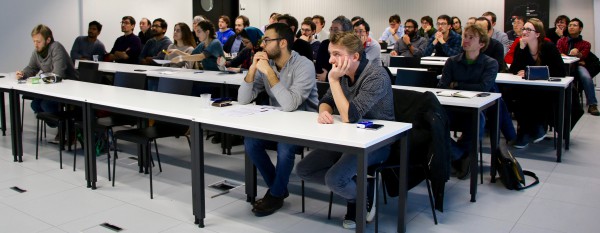MARVEL Junior Seminar — February 2019
The MARVEL Junior Seminars aim at intensifying interactions between the MARVEL Junior scientists belonging to different research groups located at EPFL. The EPFL community interested in MARVEL research topics is very welcome to attend. We believe that these events will be central for establishing a vibrant community.
Each seminar consists of two presentations of 25 minutes each, allowing to present on a scientific question in depth, followed by time for discussion. The discussion is facilitated and timed by the chair.
Pizza is served at 11:45 in the MED hall (floor 0), and after the seminar at 13:30 you are cordially invited for coffee and dessert to continue discussion with the speakers.

MARVEL Junior Seminar Organizing Committee — Francesco Ambrosio, Davide Campi, Edgar Engel, Gloria Capano, Michele Pizzochero, Kun-Han Lin, Francesco Maresca and Patrick Mayor
Abstract — Unified theory of thermal transport in crystals and glasses
M. Simoncelli1, F. Mauri2 and N. Marzari1
1 Theory and Simulation of Materials (THEOS), EPFL
2 Dipartimento di Fisica, Università di Roma La Sapienza, Italy
Crystals and glasses exhibit fundamentally different heat conduction mechanisms: the periodicity of crystals allows for the excitation of propagating vibrational waves that carry heat, as first discussed by Peierls[1]; in glasses, the lack of periodicity breaks Peierls’ picture and heat is mainly carried by the coupling of vibrational modes, often described by a harmonic theory introduced by Allen and Feldman[2]. Anharmonicity or disorder are thus the limiting factors for thermal conductivity in crystals or glasses; hitherto, no transport equation has been able to account for both. In this work, we derive such equation, resulting in a thermal conductivity that reduces to the Peierls and Allen-Feldman limits, respectively, in anharmonic-and-ordered or harmonic-and-disordered solids, while also covering the intermediate regimes where both effects are relevant. This approach also solves the long-standing problem of accurately predicting the thermal properties of crystals with ultralow or glass-like thermal conductivity[3, 4], as we show with an application to a thermoelectric material representative of this class.
[1] R. Peierls, Annalen der Physik 395, 1055 (1929).
[2] P. B. Allen and J. L. Feldman, Phys. Rev. Lett. 62, 645 (1989).
[3] Y. Wang, R. Lin, P. Zhu, Q. Zheng, Q. Wang, D. Li, and J. Zhu, Nano Lett. 18, 2772 (2018).
[4] W. Lee, H. Li, A. B. Wong, D. Zhang, M. Lai, Y. Yu, Q. Kong, E. Lin, J. J. Urban, J. C. Grossman, and P. Yang, Proc. Natl. Acad. Sci. U. S. A. (2017).
Abstract — To bend or not to bend? The dilemma of the double bond
M. Pizzochero1, M. Bonfanti2, O. V. Yazyev1 and R. Martinazzo3
1 Chair of Computational Condensed Matter Physics (C3MP), EPFL
2 Institute of Physical and Theoretical Chemistry, Goethe Universitaet Frankfurt, Germany
3 Department of Chemistry, Università degli Studi di Milano, Italy
Despite the formal similarity, the structure, stability and chemical properties of unsaturated molecules containing higher main group elements are strikingly different from their first row counterparts. This is particularly evident in group IV, since the chemical flexibility of C is not shared by its congeners. In fact, the nature and structure of multiple bonds between higher main group elements remain elusive and this hinders the development of their low-coordination chemistry. Here, focusing on the Si vs. C comparison, we shed light on this issue with the help of analytical modeling and first-principles calculations on both finite-sized and extended systems. We show that trans-bending in disilenes and buckling in silicene have a common origin, and result from a tug of war between the σ and the π bonds in which the former favor distortion and the latter oppose to it. In carbon, π bonds are stiffer and effectively resist to the distortion, but in silicon they are softer and typically succumb. As a consequence, Si structures display weaker π bonds than they could otherwise do if undistorted. Correlation between π electrons plays a major role in this context, since Coulomb repulsion moves π bonds apart from the molecular orbital limit, and renders them sensitive to doping charges. Hence, upon weakening the effective e-e repulsion in the p shell, one may completely remove any structural instability, strengthen the π bonds and turn Si into a closer relative of C than it is used to be.
Check the list of the next MARVEL Junior Seminars here.
Low-volume newsletters, targeted to the scientific and industrial communities.
Subscribe to our newsletter